Research
Here, I introduce some recently published results of research activity and so on. For the list of my publications and conference presentations, see this links.
・Probing the Relationship between Magnetic Order and Quasiparticle Excitations in YbCuS2 via Element Substitution【Aug, 2025】
・Experimental Verification of the Predictions of the Anisotropic Quantum Spin Zigzag Chain Model ―Towards the Realization of Novel Functionalities in Material―【Aug, 2025】
・Pd substitution effect on honeycomb Kondo lattice system CePt6Al3【Jul, 2025】
・Peculiar Paramagnetism in YbCuS2 under Magnetic Fields【Jan, 2025】
・Absence of Charge-Neutral Quasiparticles in YbAgSe2【Oct, 2024】
・Experimental Identification of Superconductivity with Spin Degrees of Freedom ―New Phenomena in Spin-Triplet Superconducting Multiple Phases―【Jul, 2023】
・Discovery of Charge-Neutral Quasiparticles in a Magnetic Material with a Zigzag Chain Structure【Jul, 2023】
・Mysterious Neutral Particles on YbIr3Si7 Observed by NMR!【Sep, 2022】
◎Probing the Relationship between Magnetic Order and Quasiparticle Excitations in YbCuS2 via Element Substitution
【Aug, 2025】(first author: Fumiya Hori)
We have recently focused on the magnetic semiconductor YbCuS2, which has a zigzag chain of ytterbium (Yb) ions, to explore the effects of magnetic frustration.
Previous nuclear quadrupole resonance (NQR) measurements revealed that YbCuS2 exhibits an incommensurate antiferromagnetic state with an ordered moment size smaller than the expected value below approximately 1 K.
In addition, the presence of charge-neutral quasiparticles was observed in the magnetic ordered states. To further investigate the origin of this novel ordered state and quasiparticle excitations, experiments probing the effects of element substitutions are essential.
In this study, we performed NQR measurements on Yb0.9Lu0.1CuS2, in which Yb was partially substituted with nonmagnetic lutetium (Lu), and YbCu(S0.9Se0.1)2, in which sulfur (S) was partially substituted with selenium (Se).
These substitutions correspond to magnetic dilution of the Yb sites and lattice expansion (negative chemical pressure), respectively. We revealed that both types of substitution suppress the magnetic transition temperature. Moreover, the charge-neutral quasiparticle excitations persist even after substitution.
Interestingly, these substitution-induced changes exhibit a trend opposite to that observed under pressure. Our systematic study indicates a clear relationship between the magnetic ordered states and the quasiparticle excitations in YbCuS2.
The results of this study have been published in the Physical Review B

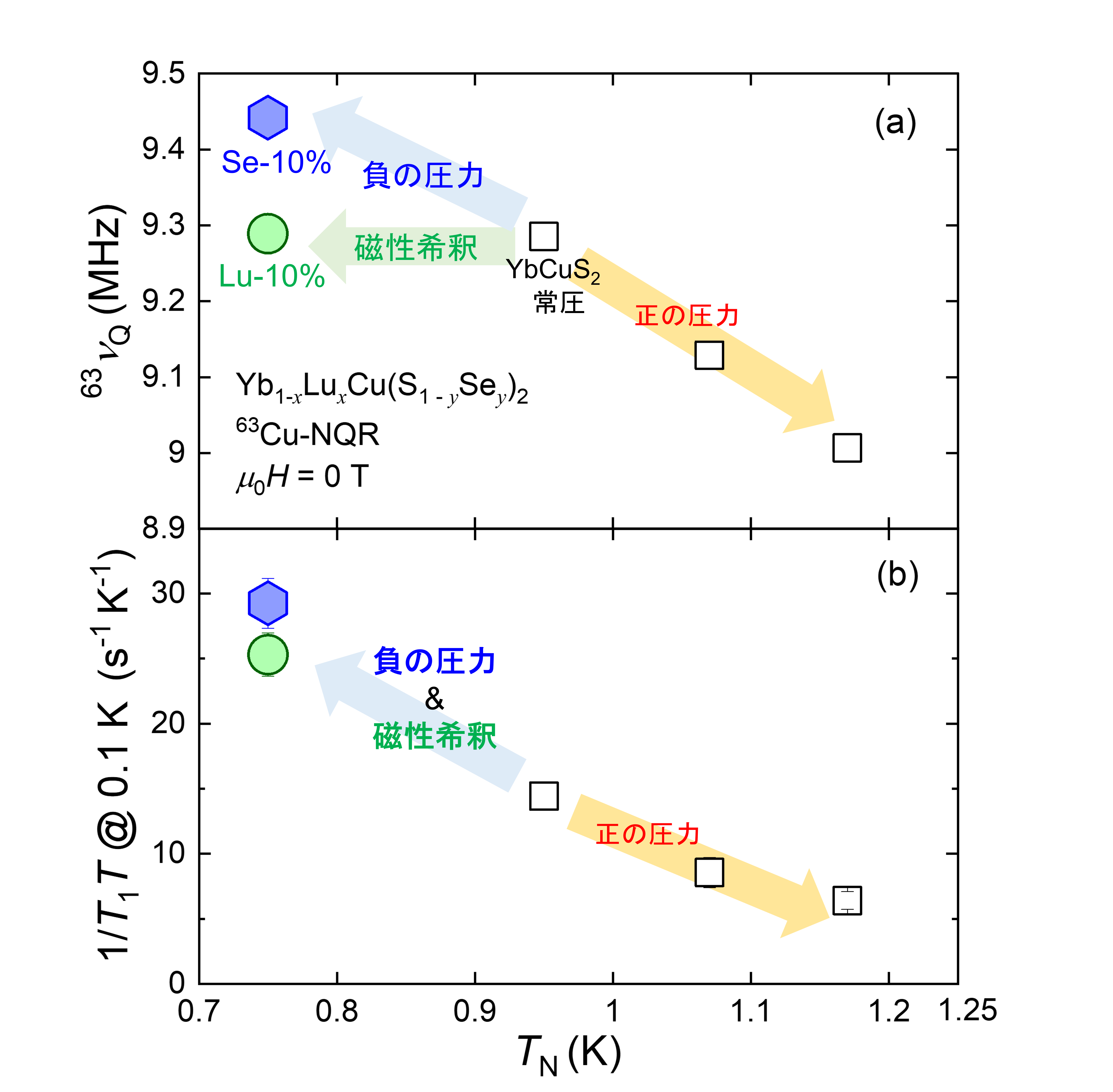
〇Article information
F. Hori, H. Matsudaira, S. Kitagawa, K. Ishida, S. Mizutani, H. Shirai, and T. Onimaru
"Lu/Se Substitution Effect on Magnetic Properties of Yb-Based Zigzag Chain Semiconductor YbCuS2"
Phys. Rev. B 112, 064414 (2025); arXiv:2412.18373.
◎Experimental Verification of the Predictions of the Anisotropic Quantum Spin Zigzag Chain Model ―Towards the Realization of Novel Functionalities in Material―
【Aug, 2025】(first author: Fumiya Hori)◎Pd substitution effect on honeycomb Kondo lattice system CePt6Al3
【Jul, 2025】(first author: Shunsaku Kitagawa)◎Peculiar Paramagnetism in YbCuS2 under Magnetic Fields
【Jan, 2025】(first author: Fumiya Hori)◎Absence of Charge-Neutral Quasiparticles in YbAgSe2
【Oct, 2024】(first author: Fumiya Hori)◎Experimental Identification of Superconductivity with Spin Degrees of Freedom
【Jul, 2023】(first author: Katsuki Kinjo)
―New Phenomena in Spin-Triplet Superconducting Multiple Phases―◎Discovery of Charge-Neutral Quasiparticles in a Magnetic Material with a Zigzag Chain Structure
【Jul, 2023】(first author: Fumiya Hori)◎Mysterious Neutral Particles on YbIr3Si7 Observed by NMR!
【Sep, 2022】(first author: Shunsaku Kitagawa)
Recently, exotic ordered states and quasiparticles not known in convenrional magnetic materials have attracted attention in condensed-matter physics.
Previously, we discovered in the magnetic semiconductor YbCuS2, in which ytterbium (Yb) atoms form a zigzag chain, an incommensurate magnetic order and charge-neutral quasiparticles.
To explain these phenomena, a new theoretical framework—the anisotropic quantum spin zigzag chain model—was proposed, leading to several predictions.
In the present study, we performed copper (Cu) nuclear quadrupole resonance (NQR) measurements on YbCuS2 under high pressure. The results revealed a pressure-induced evolution of the ground state consistent with the predictions of the theoretical model.
The high-pressure magnetic ordered state was identified as a special type of order known as odd-parity magnetic multipole order.
Furthermore, we found that the charge-neutral quasiparticles previously discovered can be controlled by applying pressure.
The results of this study have been published in the Communications Materials.
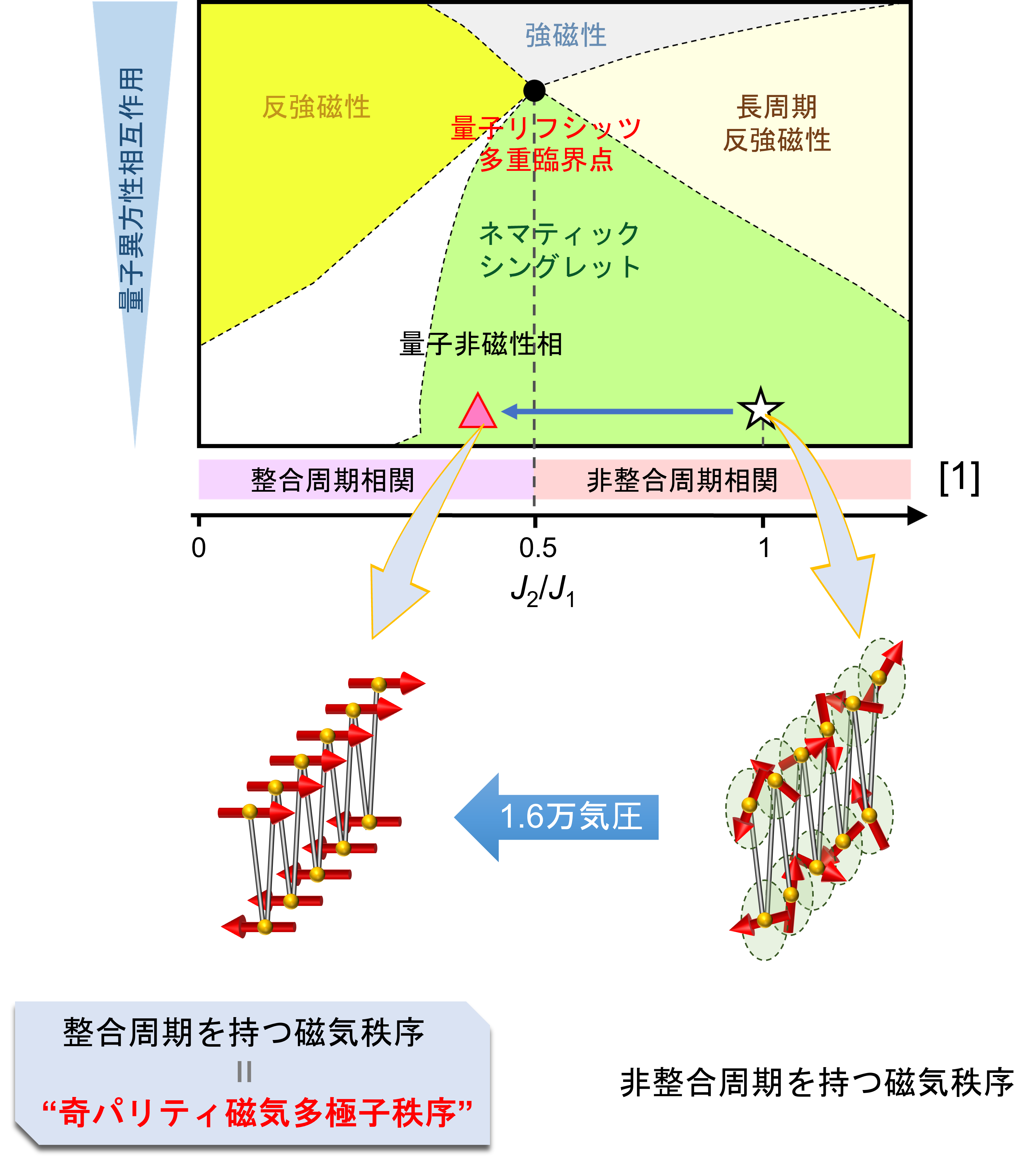
〇Article information
F. Hori, H. Matsudaira, S. Kitagawa, K. Ishida, H. Suzuki, and T. Onimaru
"Pressure evolution of magnetic structure and quasiparticle excitations in anisotropic frustrated zigzag chains"
Commun. Mater. 6, 170 (2025); arXiv:2412.17575.
Kyoto University Research Information Repository,
Kyoto University Press Release, NIKKEI
Rare-earth-based intermetallic compounds with frustrated lattices—such as triangular, kagome, and honeycomb lattices—are expected to host unconventional quantum critical phenomena arising from the interplay of the Kondo effect and magnetic frustration.
CePt6Al3 forms a honeycomb lattice of Ce atoms, where the effects of both Kondo effect and magnetic frustration are anticipated to play significant roles.
To microscopically investigate the low-temperature magnetic states from, we performed nuclear magnetic resonance (NMR) measurements on the Pd-substituted systems Ce(Pt$_{1-x}$Pd$_x$)6Al3.
We confirmed that the heavy-fermion state persists down to 0.1 K for $x = 0$, whereas Pd substitution induces antiferromagnetic ordered states.
The magnetic transition temperature remains nearly constant with increasing Pd substitution.
This behavior is distinct from that of typical heavy-fermion systems and suggests a contribution from magnetic frustration.
Furthermore, we reveal a crossover from itinerant SDW-type to localized moment antiferromagnetism as the Kondo effect weakens.
These findings establish Ce(Pt$_{1-x}$Pd$_x$)6Al3 as a promising platform for exploring the cooperative effects of Kondo effect and magnetic frustration in heavy-electron systems.
The results of this study have been published in the Journal of the Physical Society of Japan
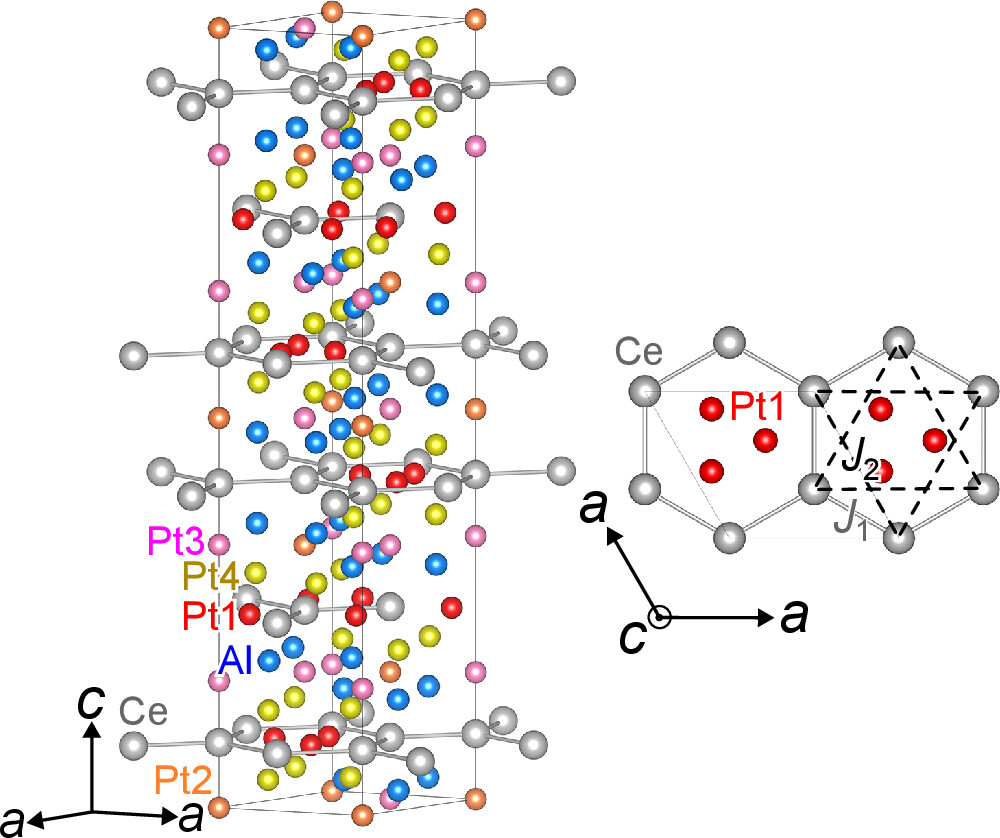
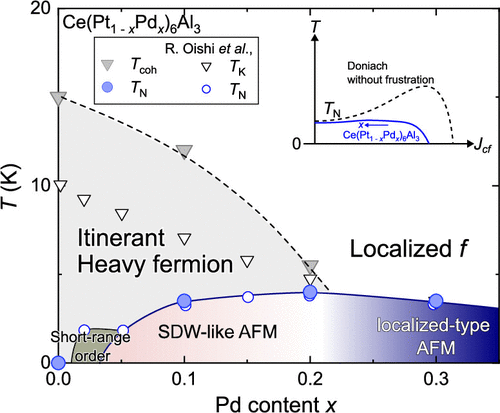
Our paper was ranked among Top 20 Most Downloaded Articles -- August 2025 in Journal of the Physical Society of Japan.
〇Article information
S. Kitagawa, F. Hori, K. Ishida, R. Oishi, Y. Shimura, T. Onimaru, and T. Takabatake
"Antiferromagnetic Order and Magnetic Frustration in the Honeycomb Heavy-Fermion System Ce(Pt$_{1-x}$Pd$_x$)6Al3: 27Al and 195Pt NMR Studies"
J. Phys. Soc. Jpn. 94, 094702 (2025); arXiv:2507.22532.
Kyoto University Research Information Repository
A magnetic semiconductor YbCuS2 has Yb zigzag chains, where the magnetic frustration is expected due to the competition between the nearest-neighbor exchange and next-nearest-neighbor exchange interactions. From the nuclear quadrupole resonance (NQR) measurements, we revealed that the system exhibits an incommensurate antiferromagnetic state with an ordered moment size smaller than the expected value below approximately 1 K. The emergence of charge-neutral quasiparticles was observed in the magnetic ordered states. In addition, magnetic-field-induced phase transitions in the magnetic ordered state were reported as shown in Fig. (a). These phenomena cannot be explained by conventional antiferromagnets.
In this study, we have performed the nuclear magnetic resonance (NMR) measurements to investigate the paramagnetic properties of YbCuS2 under magnetic fields. As shown in Fig. (b), a broad maximum of the nuclear spin-lattice relaxation rate 1/T1 was observed at around 50 K, and this anomaly is strongly suppressed by the magnetic field. Moreover, we observed an enhancement of 1/T1 at low temperatures above 3 T. These results suggest that the magnetic-field-induced modification occurs even in the paramagnetic state.
The results of this study have been published in the Journal of the Physical Society of Japan.
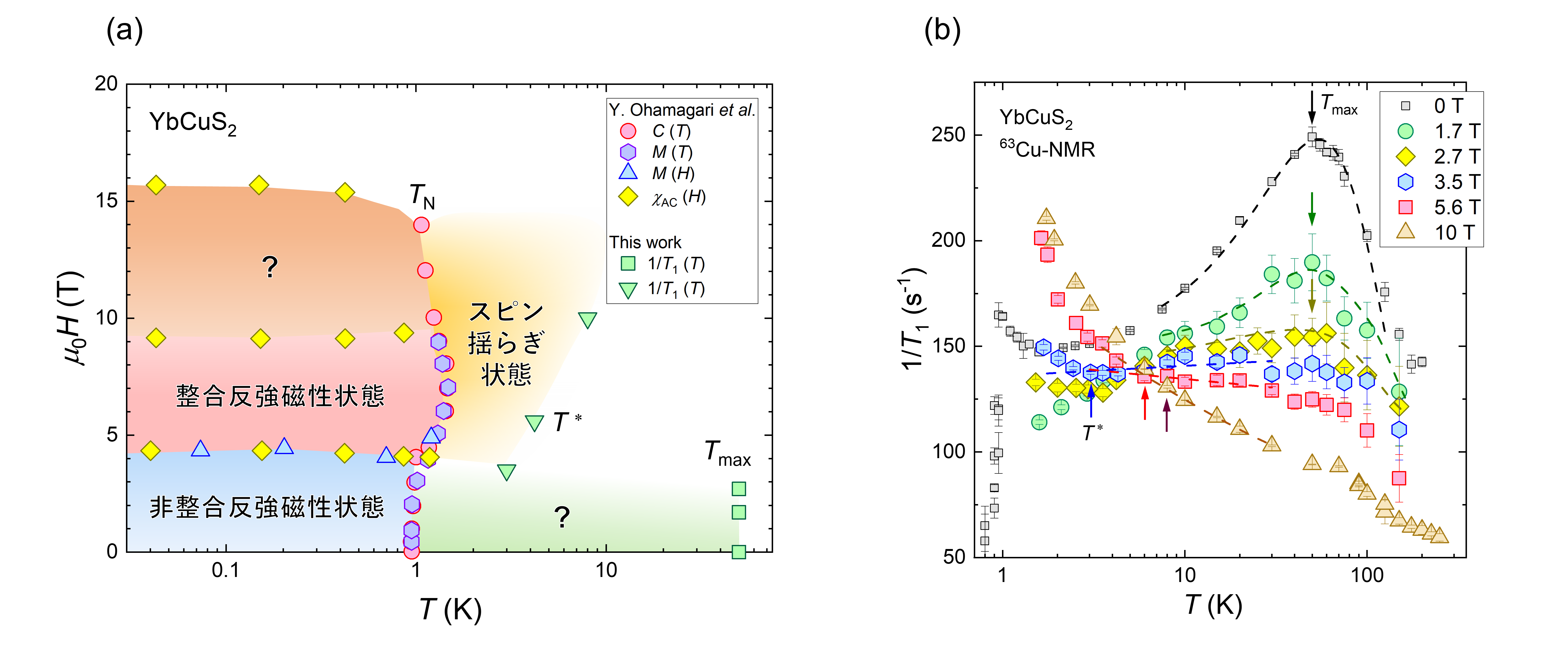
Our paper was ranked among Top 20 Most Downloaded Articles -- February 2025 in Journal of the Physical Society of Japan.
〇Article information
F. Hori, S. Kitagawa, K. Ishida, Y. Ohmagari, and T. Onimaru
"Magnetic-Field Dependence of Paramagnetic Properties Investigated by 63/65Cu-NMR on the Yb Zigzag-Chain Semiconductor YbCuS2"
J. Phys. Soc. Jpn. 94, 024706 (2025); arXiv:2502.00830.
Frustrated systems, in which spin arrangement is not uniquely determined, have attracted attention because peculiar phenomena can occur. Recently, we found a T-linear behavior of the nuclear spin-lattice relaxation rate 1/T1 in the frustrated semiconductor YbCuS2 with a Yb zigzag chain. This behavior indicates the presence of charge-neutral quasiparticles. To investigate the origin and characteristics of such novel quasiparticles observed in YbCuS2, it is highly desirable to study other Yb-based zigzag-chain compounds.
In this study, we performed nuclear magnetic resonance measurements on YbAgSe2, which is a sister compound YbCuS2. Our results indicate no evidence of the T-linear behavior of 1/T1 in YbAgSe2. This suggests that the charge-neutral quasiparticle is unique to YbCuS2.
The results of this study have been published in the Journal of the Physical Society of Japan.
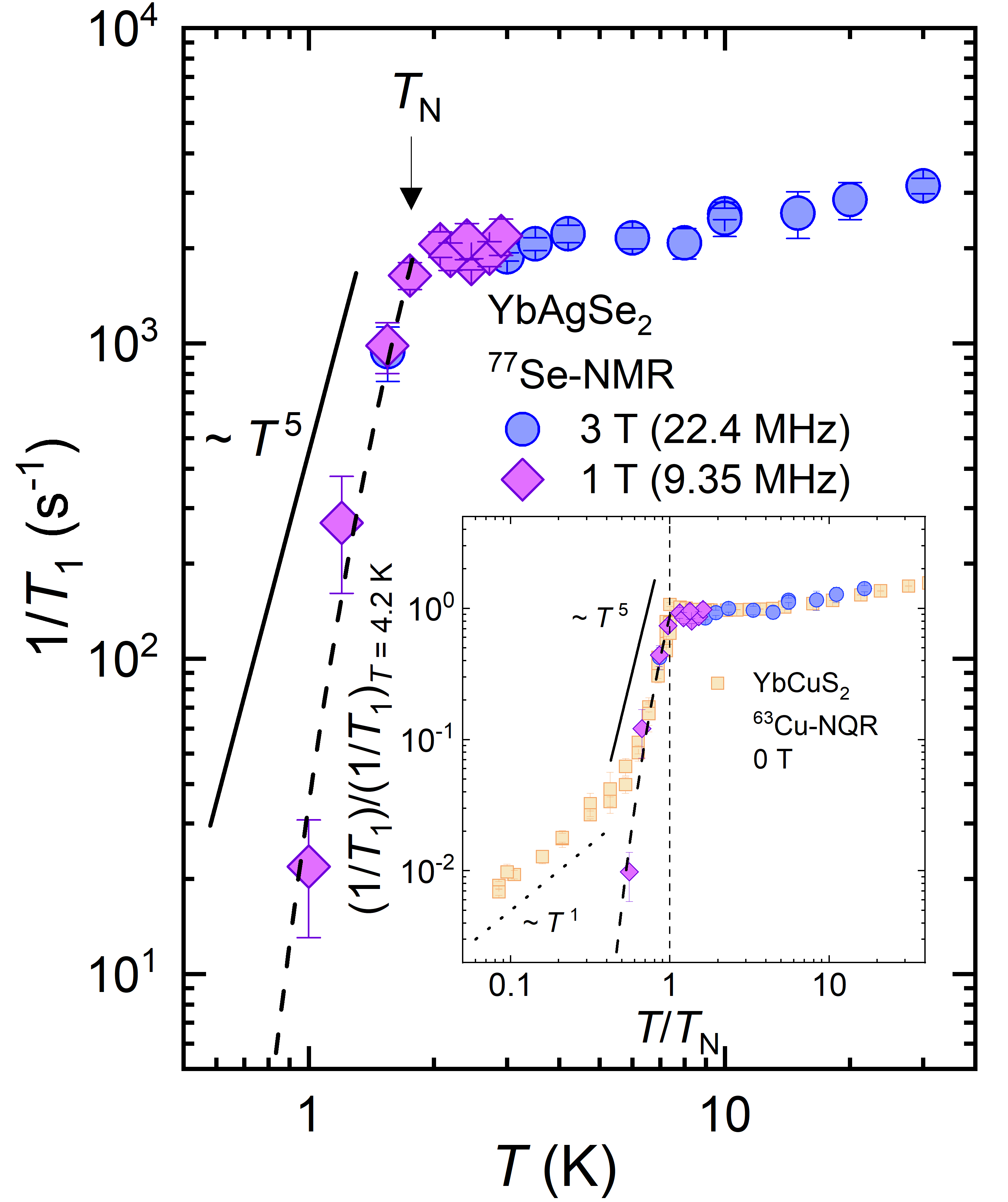
Our paper was ranked among Top 20 Most Downloaded Articles -- October 2024 and November 2024 in Journal of the Physical Society of Japan.
〇Article information
F. Hori, S. Kitagawa, K. Ishida, S. Mizutani, Y. Ohmagari, and T. Onimaru
"Gapped Spin Excitation in Magnetic Ordered State on Yb-Based Zigzag Chain Compound YbAgSe2"
J. Phys. Soc. Jpn. 93, 114702 (2024); arXiv:2411.09325.
Superconductivity is known as a phenomenon where electrical resistance becomes zero when a substance is cooled to a low temperature. In superconductivity, two electrons form a paired state (Cooper pairs). Since electrons have spin and orbital degrees of freedom, Cooper pairs also have spin and orbital degrees of freedom. However, in almost all superconductors discovered so far, the Cooper pairs have zero total spin and orbital angular momenta, and have no degrees of freedom. Therefore, only one superconducting (SC) state is realized.
On the other hand, in SC states with spin or orbital degrees of freedom, SC multiple phases can be expected, and theoretical studies have been conducted.
However, since there are very few observed examples of such superconductors and SC transition temperature is low, it has been extremely difficult to search for phenomena derived from SC multiple phases.
We have investigated the SC spin rotation originating from the SC multiple phases in the superconductor UTe2 by nuclear magnetic resonance (NMR) measurements in a complex extreme environment.
Our results provide microscopic evidence for the remaining the spin degrees of freedom in the superconductivity of UTe2, inherent to the spin-triplet superconductivity.
The results of this study have been published in the Science Advances.
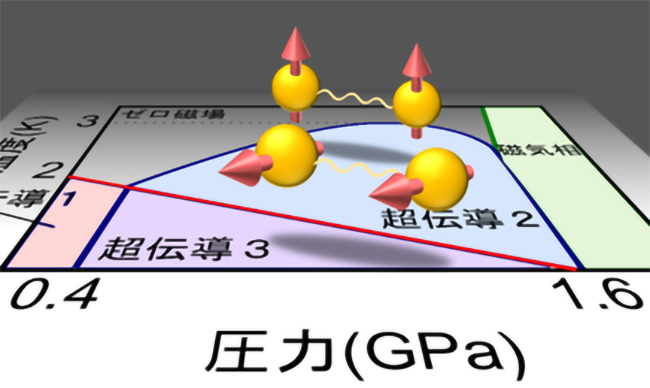
〇Article information
Recently, exotic ordered states and quasiparticles not known in convenrional magnetic materials have attracted attention in condensed-matter physics. In particular, it is expected that such peculiar phenomena can appear in frustrated systems where the spin arrangement of the entire systems is not uniquely determined. We focused on the magnetic semiconductor YbCuS2, where rare-earth ytterbium atoms (Yb) form zigzag chains, and investigated the frustration effect of the rare-earth zigzag chain. Nuclear quadrupole resonance (NQR) and specific heat measurements revealed that YbCuS2 exhibits an incommensurate antiferromagnetic (AFM) order and neutral quasiparticles exsit on AFM ordered states of YbCuS2.
K. Kinjo, H. Fujibayashi, H. Matsumura, F. Hori, S. Kitagawa, K. Ishida., Y. Tokunaga, H. Sakai, S. Kambe, A. Nakamura, Y. Shimizu, Y. Homma, D. Li, F. Honda, and D. Aoki
"Superconducting spin reorientation in spin-triplet multiple superconducting phases of UTe2"
Sci. Adv. 9, eadg2736 (2023); arXiv:2307.15784.
Kyoto University Research Information Repository,
Kyoto University Press Release
Since the results of this study cannot be explained by the theory of conventional zigzag-chain frustrated magnets, it indicates the necessity of a new theory and suggests that YbCuS2 is one of promising platforms for new frustrated magnets.
The results of this study have been published in the Communications Materials.
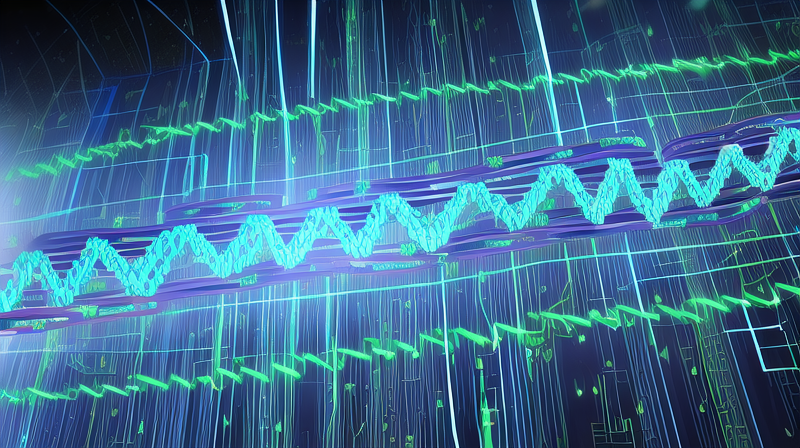
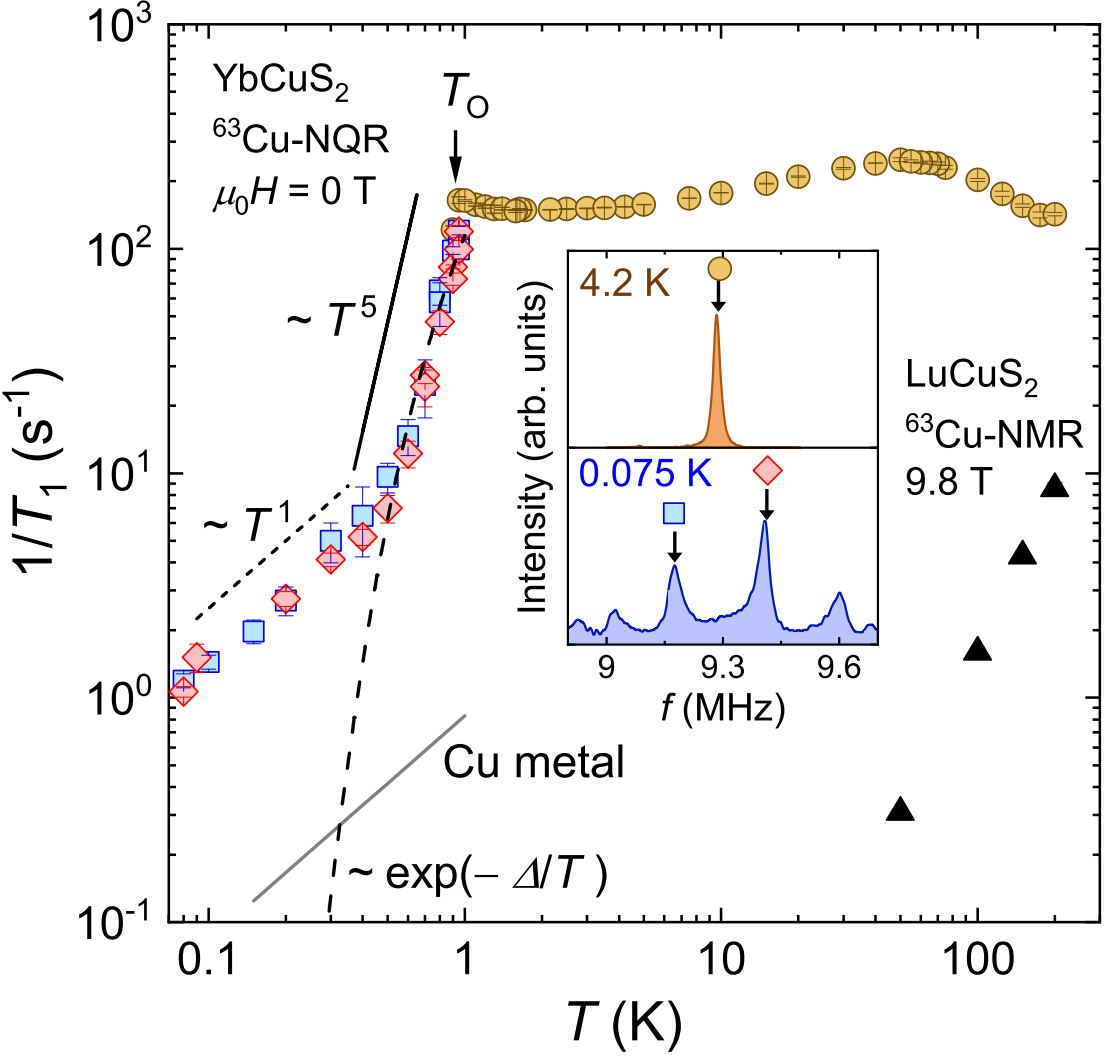
〇Article information
F. Hori, K. Kinjo, S. Kitagawa, K. Ishida, S. Mizutani, R. Yamamoto, Y. Ohmagari, and T. Onimaru
"Gapless fermionic excitation in the antiferromagnetic state of ytterbium zigzag chain"
Commun. Mater. 4, 55 (2023)
; arXiv:2201.07563.
Kyoto University Research Information Repository,
Kyoto University Press Release, Yahoo! News
Materials are classified into two types, metals and insulators, depending on whether or not electricity flows through them.
Metals have the property of easily conducting heat, while insulators have the property of being difficult to conduct heat.
This is because conduction electrons, which conduct electricity in metals, carry heat.
In recent years, materials have been discovered that conduct heat in the same manner as metals, although they are electrically insulating and do not conduct electricity, and have attracted attention.
Since there are no conduction electrons in insulators, it is believed that these materials contain mysterious charge-neutral particles that carry only heat.
YbIr3Si7 is one example of such materials, and the existence of charge-neutral particles has been reported from specific heat and thermal conductivity measurements at low temperatures.
We performed nuclear magnetic resonance measurements (NMR) on YbIr3Si7 to investigate the magnetic response of charge-neutral fermions from a microscopic perspective.
As a result, we found that the charge-neutral particles in YbIr3Si7 are closely related to its magnetic properties. Our findings shed light on the origin of charge-neutral particles in insulators.
The results of this study have been published in the Physical Review B.
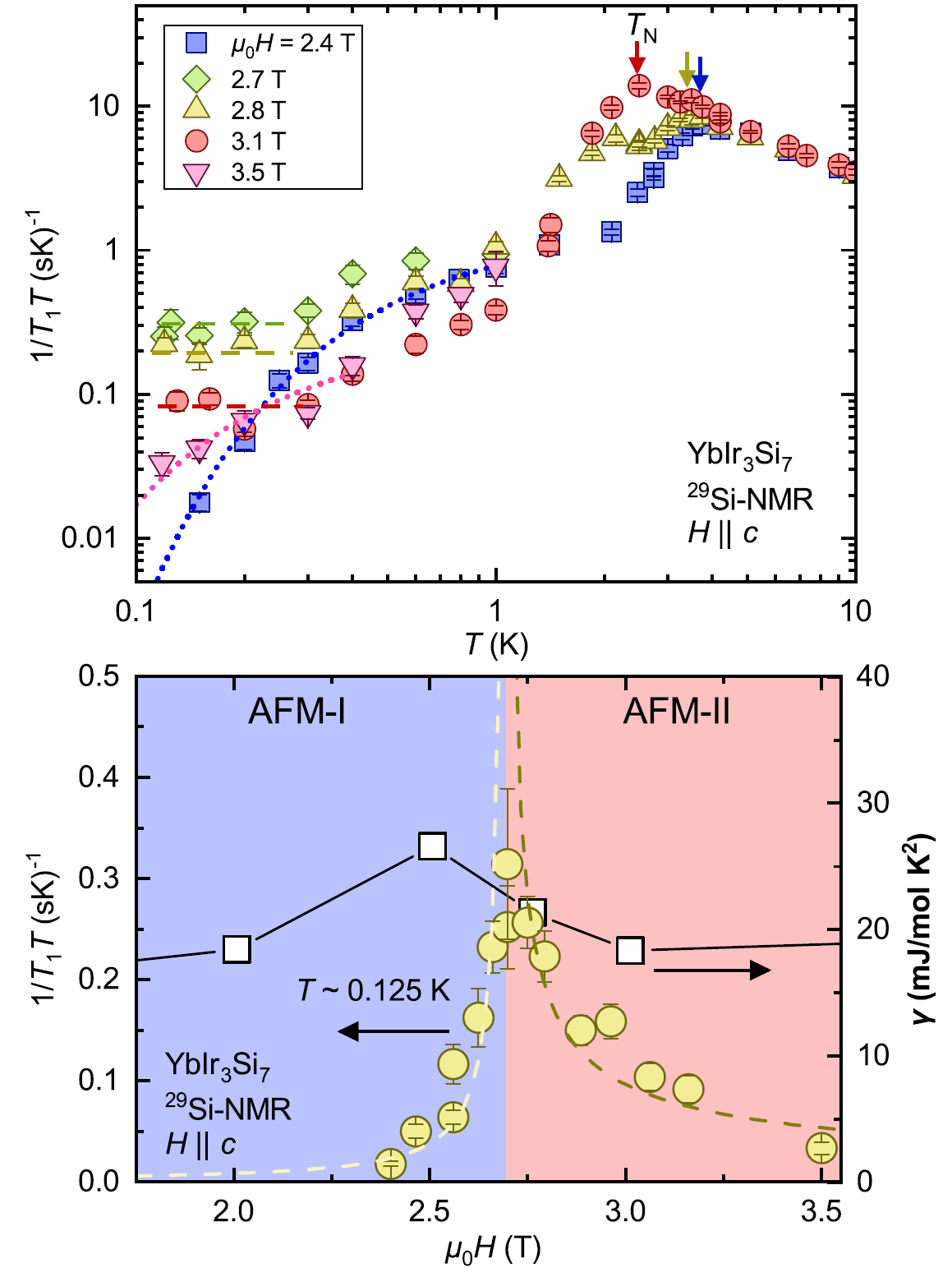
〇Article information
S. Kitagawa, T. Kobayashi, F. Hori, K. Ishida, A. H. Nevidomskyy, L. Qian, and E. Morosan
"Enhancement of charge-neutral fermionic excitations near the spin-flop transition in the magnetic Kondo material YbIr3Si7"
Phys. Rev. B 106, L100405 (2022) ; arXiv:2209.10844.
Kyoto University Research Information Repository